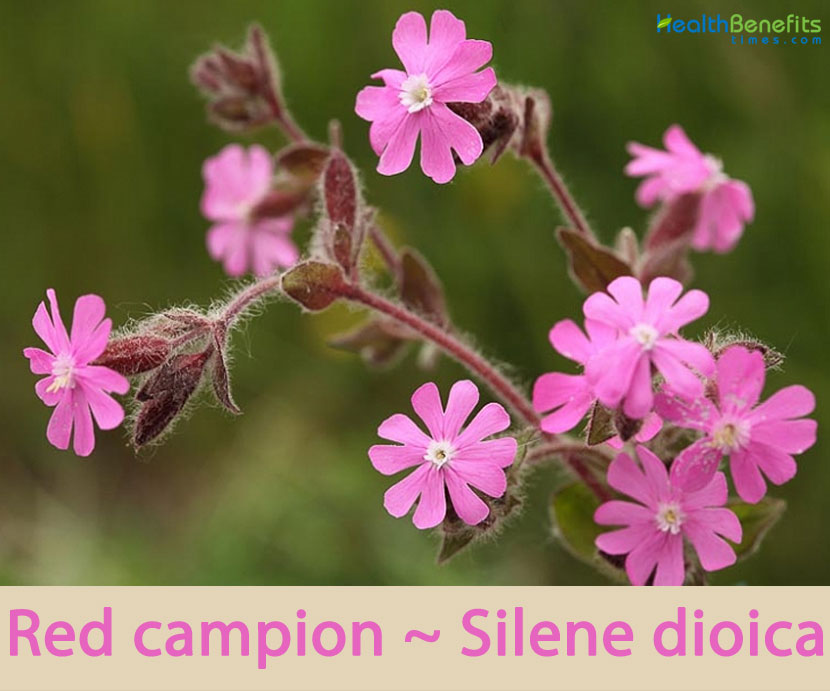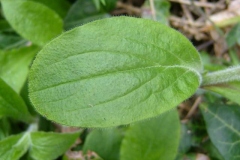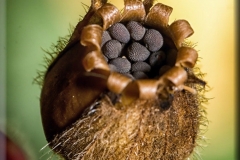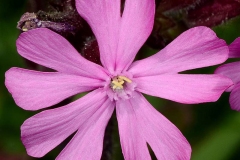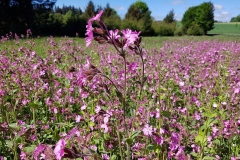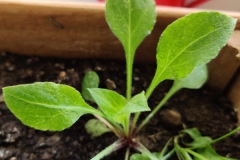| Red campion Quick Facts | |
|---|---|
| Name: | Red campion |
| Scientific Name: | Silene dioica |
| Origin | Throughout central, western and northern Europe, and locally in southern Europe |
| Shapes | Broadly ovoid to globose capsule 10–15 mm long containing numerous seeds |
| Name | Red campion |
|---|---|
| Scientific Name | Silene dioica |
| Native | Throughout central, western and northern Europe, and locally in southern Europe. It has been introduced in Iceland, Canada, the US, and Argentina |
| Common Names | Morning campion, Red campion, Red catchfly, Red cockle, rough robin, Lord, God Of Blood, Red Night Elke, Red Forest Elke, Taglicht Elke |
| Name in Other Languages | Armenian: Hamaspram (Համասպրամ) Belarusian: Smalianka (Смалянка) Bulgarian: Dvudomno plyuskaviche (двудомно плюскавиче) Catalan: Melandri vermell Chinese: Hong jian qiu luo Croatian: Crveni golesak, crvena pušina Czech: Silenka dvoudomá, knotovka červená, silenka červená Danish: Dag-Pragtstjerne Dutch: Dagkoekoeksbloem English: Morning campion, Red campion, Red catchfly, Red cockle, rough robin Estonian: Punane pusurohi Finnish: Puna-ailakki French: Compagnon-rouge, Lychnis dioïque, Lychnis fleur de coucou, Silène dioïque, Silène rouge, ivrogne, lychnis du jour, mélandrie du jour, robinet rose, robinet rouge Georgian: Sast’vena (სასტვენა) German: Rote Waldnelke, Rote Lichtnelke, rote Tagnelke, rote Nachtnelke Hungarian: Piros mécsvirág Icelandic: Dagstjarna Irish: Coireán coilleach Italian: Silene dioica, femerone rosso, gittaione rosso, gittone rosso Japanese: Reddokyanpion (レッドキャンピオン), Akebonosen’nou (アケボノセンノウ) Latvian: Sarkanā spulgotne Lithuanian: Raudonžiedis šakinys, raudonžiedė naktižiedė Norwegian: Rød jonsokblom, Aaker-nelliker, Rødfot-græs, Vilde-nelliker, Raud jonsokblom, Ruksesluffellaš, Guppaslieđđi, Ruksesluffilasta, Ruksesrássi Polish: Bniec czerwony Russian: Droma dvudomnaya (Дрёма двудомная), smolovka lesnaya (смолёвка лесная) Scottish Gaelic: Cìrean-choilich, Cìrein-choilich Slovak: Silenka červená, knôtovka červená, silenka dvoudomá Slovene: Rdeči slizek Spanish: Borbonesa, colleja rocha Swedish: Rödblära, Skogslyse, Skoglyst rödblära, Skogslyst Turkish: Catal nakıl Ukrainian: Kukolytsya dvodomna (куколиця дводомна) Walloon: Brin-d’-leu Welsh: Blodau Neidr, Blodeuyn Rhudd, Blodyn Crach, Blodyn Neidr, Blodyn Taranau, Blodyn y Neidr, Botwm Mab Leuanc, Ceiliog Coch, Coch y Taranau, Gludlys Coch, Lluglys Blodeuyn Rhudd, Lluglys Ysgar, Llys yr Ychain, Llys yr Ychen, Llysiau Robin |
| Plant Growth Habit | Hairy, short-lived herbaceous biennial or perennial flowering plant |
| Growing Climates | Woods, hedgerows, ledges of cliffs, deciduous woodlands, woodland margins and clearings, gardens, riverbanks, open waste places, rocky slopes, stabilized screes, seashore, broad-leaved forests, coppices, yards, banks, wasteland, fell precipices |
| Soil | Prefers fertile, well drained, non-acid, base-rich or calcareous soils |
| Plant Size | Up to 20cm tall and erect flowering stems 30 – 90cm tall |
| Stem | Erect, simple or basally branched, 20–90 cm high |
| Leaf | 20–90 mm long, 3–45 mm wide; basal leaves long-petiolate, obovate-oblong; cauline leaves oblong-elliptic, acute to acuminate, shortly petiolate to subsessile, petiole 0–30 mm long |
| Flowering season | May to June |
| Flower | Dark pink to red flowers, each 1.8-2.5 cm across. There are five petals which are deeply notched at the end, narrowed at the base and all go into an urn-shaped calyx. As indicated by the specific name, male and female flowers are borne on separate plants |
| Fruit Shape & Size | Broadly ovoid to globose capsule 10–15 mm long containing numerous seeds, opening at the apex by 10 teeth which curve back |
| Seed | Dark brown to black, broadly reniform, plump, 1-1.6 mm, densely and evenly papillate |
| Propagation | By seed or by division |
| Plant Parts Used | Leaves, Blütten, Seeds, Roots |
| Season | June to August |
| Traditional Uses |
|
Plant Description
Red campion is a hairy, short-lived, herbaceous biennial or perennial flowering plants that normally grow up to 20 cm tall and erect flowering stems are 30 – 90 cm tall. The plant is found growing in woods, hedgerows, ledges of cliffs, deciduous woodlands, woodland margins and clearings, gardens, yards, banks, riverbanks, open waste places, rocky slopes, stabilized screes, seashore, broad-leaved forests, coppices, wasteland and fell precipices. The plant prefers fertile, well drained, non-acid, base-rich or calcareous soils. Stems are erect, simple or basally branched, 20–90 cm high.
Leaves
Leaves are 20–90 mm long and 3–45 mm wide. Basal leaves are long-petiolate, obovate-oblong and cauline leaves are oblong-elliptic, acute to acuminate, shortly petiolate to sub sessile. Petiole is 0–30 mm long. Both the leaves and stems of the plant are hairy and slightly sticky. The upper leaves are stalk less.
Flowers
It is a biennial or perennial plant, with dark pink to red flowers, each 1.8-2.5 cm across. There are five petals which are deeply notched at the end, narrowed at the base and all go into an urn-shaped calyx. As indicated by the specific name, male and female flowers are borne on separate plants (dioecious), the male with 10 stamens and a 10-veined calyx, the female with 5 styles and a 20-veined calyx. The flowers are unscented. The flowering period is from May to October and the flowers are frequently visited by flies, like Rhingia campestris.
Fruit
The fruit, produced from July onwards, is a broadly ovoid to globose capsule 10–15 mm long containing numerous seeds, opening at the apex by 10 teeth which curve back. Seeds are dark-brown to black, broadly reniform, plump, 1–1.6 mm, densely and evenly papillate.
Some Facts
- The root is used as a soap substitute for washing clothes etc.
- The soap is obtained by simmering the root in hot water.
- In the Language of Flowers red campion symbolizes gentleness.
References:
http://www.theplantlist.org/tpl1.1/record/kew-2488209
https://pfaf.org/user/Plant.aspx?LatinName=Silene+dioica
https://www.cabi.org/isc/datasheet/117137
https://www.itis.gov/servlet/SingleRpt/SingleRpt?search_topic=TSN&search_value=20064#null
https://www.inhs.illinois.edu/data/plantdb/detail/395
https://en.wikipedia.org/wiki/Silene_dioica
https://profiles.ala.org.au/opus/foa/profile/Silene+dioica
http://sppaccounts.bsbi.org/content/silene-dioica-1.html
https://gd.eppo.int/taxon/MELRU


